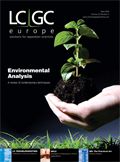Digital Update
Forensics and toxicology database; Informatics development platform; Supporting Connectivity; Metabolite database
Forensics and toxicology database
The G6855 MassHunter Forensic and Toxicology Database from Agilent Technologies can, according to the company, identify 7500 compounds with high confidence, based on LC–MS data. The database contains accurate-mass data for compounds, which are of interest to forensics and toxicology investigators gathered from around the world. It includes software for searching, editing and creating user-customizable content. The database also features a ranking and scoring algorithm that assigns a confidence level for each match. The database accommodates the addition of LC retention times, which, combined with accurate mass results, reportedly provides a significantly increased confidence when confirming compound identity. The company also offers an accurate-mass database for pesticides and plans to develop additional accurate mass databases for other analyses
Informatics development platform
Labtronics has updated its Nexxis Application Development Platform. Described by the company as a powerful development tool and a robust platform for deploying, managing and executing laboratory informatics applications, the platform is reported to provide a development environment that takes care of the core requirements of laboratory informatics applications. The update includes upgrades to the application framework to improve overall performance, form designer and display updates that provide faster display configuration with more configuration options and the centralization of integration with SDMS, to create what the company calls a "configure once, use often" environment, so that integration parameters configured centrally can be used by any applications running on the platform.
Supporting Connectivity
Octagon Research Solutions has announced the availability of the ViewPoint Connector Module, which is standalone software that supports connectivity to popular content management systems. According to the company the connector's document and data integration features facilitate two-way communication with content management repositories, respect security defined within the content management system and provide a fundamental building block for applications that are integrating with those systems. The connector works with content management systems including EMC's Documentum 6 and Microsoft's SharePoint 3.0.
Metabolite database
The latest version of the Symyx Metabolite Database has been released by Symyx Technologies. The company claims that it is the largest and most comprehensive collection of drug metabolism data in the world and it is now available to pharmaceutical, agrochemical and biotechnology researchers from the company's Isentris data access, analysis and decision support system, as well as the web-based DiscoveryGate content platform. According to the company the database makes it possible for scientists to focus on the most therapeutically promising compounds, those with the right metabolic profile-early in the discovery process. Using the software's structure-searchable metabolic schemes, biotransformation explorer and query and browse tools, the company states that scientists can quickly explore the fate of parent compounds, their metabolites and properties. The database's range of xenobiotic transformations and metabolic schemes reportedly come from respected published sources, as well as non-proprietary metabolism studies from new drug applications published by the US Food and Drug Administration.


New Study Reviews Chromatography Methods for Flavonoid Analysis
April 21st 2025Flavonoids are widely used metabolites that carry out various functions in different industries, such as food and cosmetics. Detecting, separating, and quantifying them in fruit species can be a complicated process.
Analytical Challenges in Measuring Migration from Food Contact Materials
November 2nd 2015Food contact materials contain low molecular weight additives and processing aids which can migrate into foods leading to trace levels of contamination. Food safety is ensured through regulations, comprising compositional controls and migration limits, which present a significant analytical challenge to the food industry to ensure compliance and demonstrate due diligence. Of the various analytical approaches, LC-MS/MS has proved to be an essential tool in monitoring migration of target compounds into foods, and more sophisticated approaches such as LC-high resolution MS (Orbitrap) are being increasingly used for untargeted analysis to monitor non-intentionally added substances. This podcast will provide an overview to this area, illustrated with various applications showing current approaches being employed.

.png&w=3840&q=75)

.png&w=3840&q=75)



.png&w=3840&q=75)



.png&w=3840&q=75)








